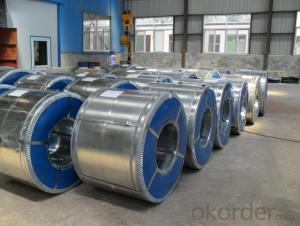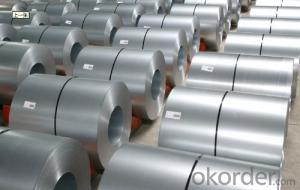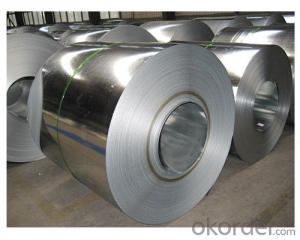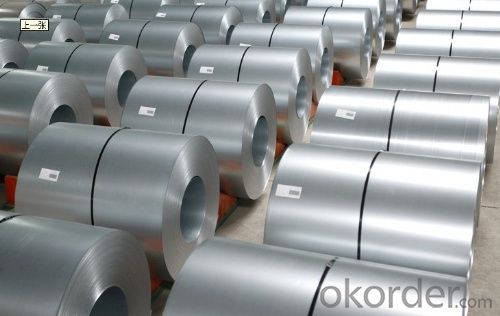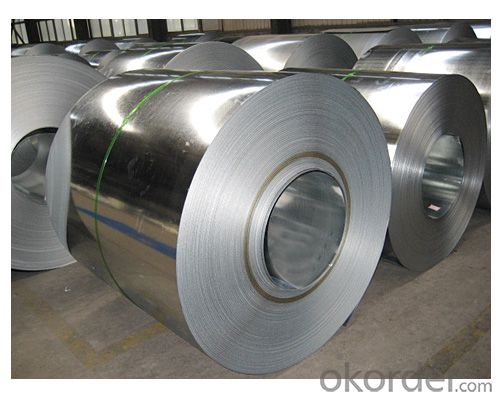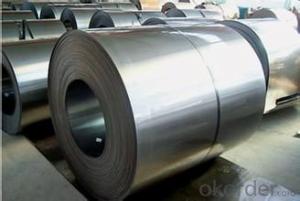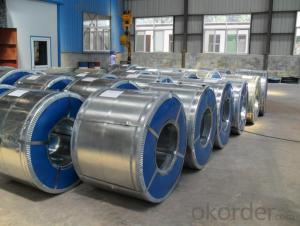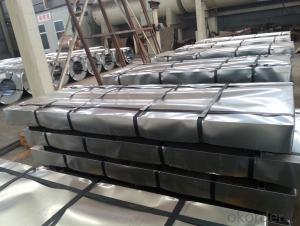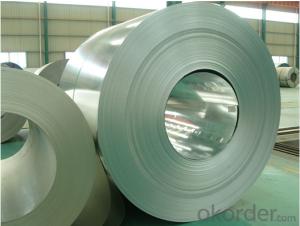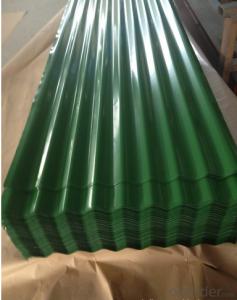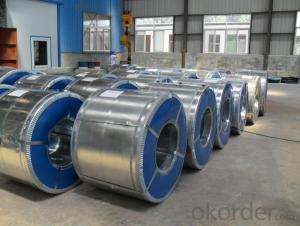Prime Quality Hot-dip galvanized steel coil and sheet
- Loading Port:
- Tianjin
- Payment Terms:
- TT OR LC
- Min Order Qty:
- 50 m.t.
- Supply Capability:
- 10000 m.t./month
OKorder Service Pledge
OKorder Financial Service
You Might Also Like
Commodity | Hot dip galvanized steel coil and sheet |
Technical Standard: | JIS 3302 / ASTM A653 / EN10143 |
Grade | DX51D / DX52D/ DX53D/ S250,280,320GD |
Types: | Commercial / Drawing / Deep Drawing / Structural quality |
Width | 500/650/726/820/914/1000/1200/1219/1220/1250mm |
Thickness | 0.12-2.8mm |
Type of coating: | Galvanized |
Zinc coating | Z30-275g/m2 |
Surface Treatment | Chromed / Skin-pass/ Oiled/Slightly Oiled/ Dry/ Anti-fingerprint |
Surface structure: | Zero spangle / minimized spangle / regular spangle/ big spangle |
ID coil | 508mm or 610mm |
Coil weight | 3-8 MT per coil |
Package: | Properly packed for ocean freight exportation in 20''containers |
Application: | Industrial panels, roofing and siding for painting |
Price terms | FOB,CFR,CIF |
Payment terms | T/T or L/C |
Delivery time | Within 30 days |
Remarks | Insurance is all risks |
MTC will be handed on with shipping documents | |
We accept the third party certification test,such as SGS/BV |
- Q: What are they worth today? As well as a 1943 steel nickel?
- The 1943 zinc coated steel cent is very common in circulated grades. They were saved by a lot of people because they are a one year type coin. I can buy them for .02 to .10 each depending on grade. Uncirculated ones are worth more, a few dollars. There is no such thing as a 1943 steel nickel. The nickel that year were made of 56% copper,35% silver and 9% manganese. The 1943 nickel sells for around a $1 in very fine to $2 in extra fine. It is worth more in high grade mint state.
- Q: So I'm trying to decide which is better. I've always had aluminum on my 6 yr old tb gelding as I do hunters on him. He's never had steel on but I've recently moved and the shoer here is more expensive. So is aluminum really worth the extra cash to keep him light on his feet or is steel really not that much different?
- Steel is not much different to be honest as long as you aren't doing any special shoes. A horse like yours I would probably stick in some steel eventers and go on your way. That's about average and honestly between a comparable aluminum shoe you won't see a difference in his movement unless the farrier starts messing with breakovers and shoeing him different. There are few times when I will do aluminum and all of it has to do with special circumstances. My 4 year old is in aluminums on his front right now because his special shoes are close to an 3/4 thick and about an inch wide. In steel those shoes would be very heavy, but those are what he works best in compared to the steel. I can give him more of the support he needs with the aluminum than I can with the steel. I also prefer eggbars, hartbars, etc to be done in aluminum for the sheer size of the shoe. Steel lasts more resets and it's stronger than aluminum. Aluminum is useful for therapuedic shoes. So you all have the pros and cons, but a horse in shoes with no special needs is a horse who should just stay in steel.
- Q: I received a very nice set of stainless steel cookware as a wedding gift. While very pretty, Im finding them almost useless for cooking. Everything sticks, they're difficult to clean, and Im using my old non-stick pans instead. Should I simply leave the stainless out for decortive purposes, or are stainless steel pans better for some applications?
- Stainless steel has some benefits: 1) Dishwasher safe: my anodized aluminum pots are NOT dishwasher safe (my wife put one in and it lost its gun-metal gray finish - sad) 2) Conductivity: most stainless steel cookware has an aluminum (or copper) middle - this transfers the heat nicely - steel by itself does not conduct heat evenly. All Clad cookware refers to the fact that the aluminum within the cookware is clad in steel. 3) Aesthetics: stainless is pretty. Stainless is not anti-stick, so you'll have to use all your skills to avoid sticking. 1) Use oil or butter: heat your pan before oiling. Once to temp, add the oil/butter and wait for it to heat-through. THEN add your food - sticking should be minimized. 2) Move your food around a lot: once you add a piece of food that is likely to stick, move it shortly afterward. This will prevent the food from gluing itself to one spot in the pan - a crust will start to appear, and that will protect the food from sticking. 3) Love the fond: anti-stick pans don't have a good chance at fond development (fond is the stuff that sticks to the bottom of the pan, and is crucial to pan sauce creation). You should experiment with your cookware, or send it to me: I am wishing for some new cookware.
- Q: Will any modified choke or improved Cylinder choke be safe to use with steel shot? If these are safe, which is better for duck or goose hunting?
- Lead shot can be fired through any choke. Steel shot requires a choke tube that is made for it.
- Q: I expect that I will be questioned about my knowledge in methoding for steel castings, in a interview. I dont know about it. Can someone explain me in simple language and give me some links, like how I can explain methoding for steel castings.....key points...help please...so that i will pass the interview as if I have experience in methoding....thanks
- It is very difficult to define Methoding of Steel castings by one sentence. Actually it encompasses the total casting process. Normally it would mean a) Pattern design i.e. what type of pattern it would be- wooden, metallic, split or full, loose or fitted on a match plate or any other, how will be the parting line. b) Design of the gating system. c) Design of risering i.e. numbers, size and location of risers. d) Design of molding process i.e. sand system to be used, mold box size. But to do justice to the above mentioned activities, you need to consider other parameters of the casting process such as chemical composition, solidification characteristics, pouring temperature, pouring time, knock out time etc. As I said Methoding of Steel castings means designing of the total casting process from inception to final product.
- Q: How do steel coils perform in high-pressure applications?
- Due to their robust and durable nature, steel coils are highly effective in high-pressure scenarios. The exceptional tensile strength of steel enables it to endure immense pressure without any distortion or breakdown. Moreover, steel coils are specifically engineered to retain their shape and structural integrity even under the most extreme pressure, making them ideal for deployment in a wide range of high-pressure applications such as hydraulic systems, pressure vessels, and industrial machinery. Furthermore, the exceptional resistance of steel coils to corrosion and high temperatures further augments their performance in high-pressure environments. These qualities, coupled with their reliability and capacity to withstand high pressure, render steel coils the preferred choice for industries seeking resilient and efficient equipment.
- Q: Is cold steel actually steel? Does it hurt? Why is it used in training? First one to goodly answer those questions gets 10 points.
- Cold Steel is a Ventura, California-based marketer of knives, swords and other edged weapons and tools. Cold Steel was founded in 1980 by company president, Lynn C. Thompson.[1] Its products are manufactured in various countries including Japan, Taiwan, China and India.[2] Cold Steel's products include fixed blade knives, folding knives, swords, machetes, tomahawks, kukris, blowguns, walking sticks, and other martial arts related items.[1] Many of their knives are also made using VG-1 Stainless Steel,4116 Krupp Stainless Steel, 1055 Carbon Steel, SK-5 High Carbon Steel, and AUS 8A Stainless Steel.[3]
- Q: I am looking for steel. I need a lot.
- Ryerson-Tull sells all sorts of steel. As does Liebovitch. I'm not what the phone numbers are to these places, but I'm sure you could find them on the internet.
- Q: Can steel coils be used in the production of furniture?
- Yes, steel coils can be used in the production of furniture. Steel coils are often used as a raw material in the manufacturing of various types of furniture, such as chairs, tables, and bed frames. Steel coils provide strength, durability, and stability to the furniture, making it suitable for heavy-duty use. Additionally, steel coils can be shaped into different designs and sizes, allowing for versatility in furniture production. The coils can be transformed into various components, such as the frame or support structure of the furniture, providing a solid foundation. Moreover, the use of steel coils in furniture production can enhance the overall aesthetics of the furniture, as they can be finished in different colors and coatings to match the desired style. Overall, steel coils are a common and practical choice for furniture manufacturers due to their strength, durability, and design possibilities.
- Q: What are the common uses of galvanized steel coils?
- Galvanized steel coils are commonly used in various industries such as construction, automotive, and manufacturing. They are primarily used for making metal roofs, walls, and fences due to their corrosion-resistant properties. Additionally, galvanized steel coils are utilized in the production of air conditioning ducts, electrical appliances, and agricultural equipment.
Send your message to us
Prime Quality Hot-dip galvanized steel coil and sheet
- Loading Port:
- Tianjin
- Payment Terms:
- TT OR LC
- Min Order Qty:
- 50 m.t.
- Supply Capability:
- 10000 m.t./month
OKorder Service Pledge
OKorder Financial Service
Similar products
Hot products
Hot Searches
Related keywords
